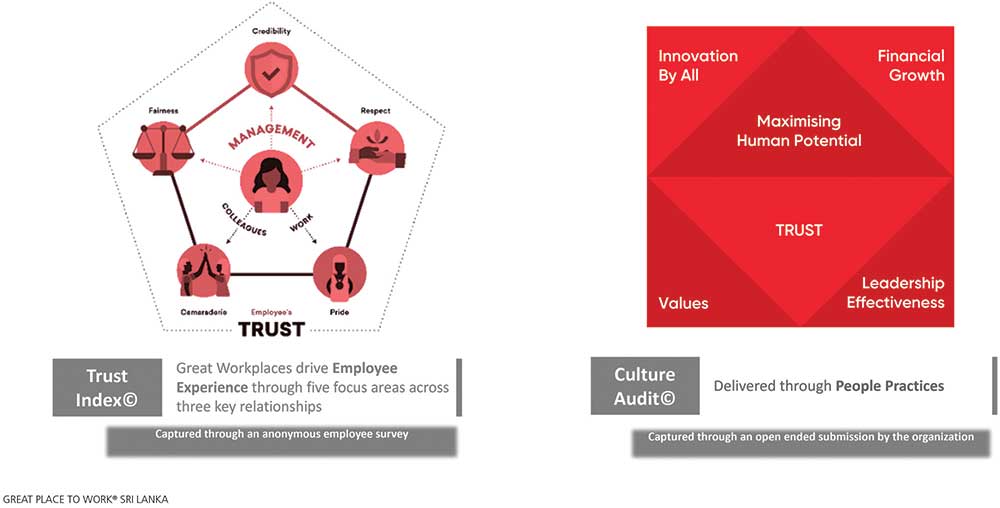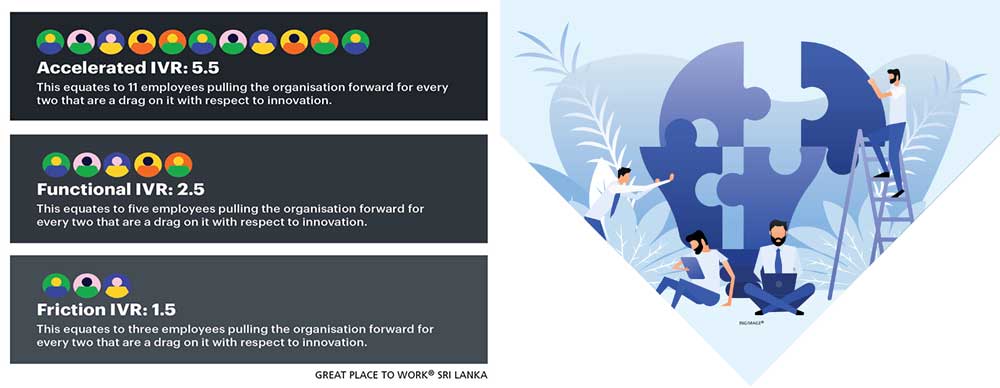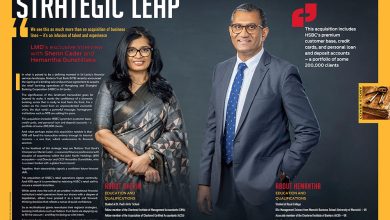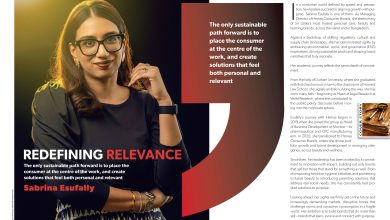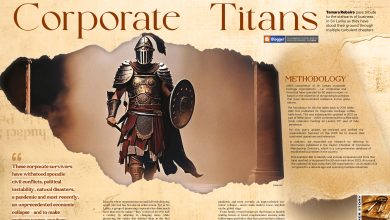

ASSESSMENT METHODOLOGY
 Great Place to Work® Inc. is a pioneer that has been studying and recognising the Best Workplaces™ around the world for more than 30 years. It is based in over 90 countries and assesses organisations across 170 territories.
Great Place to Work® Inc. is a pioneer that has been studying and recognising the Best Workplaces™ around the world for more than 30 years. It is based in over 90 countries and assesses organisations across 170 territories.
The Sri Lankan study is based on the global model and a rigorous methodology – it has been researched, evaluated and conducted in similar studies around the world. This model applies across all geographies as it primarily measures hygiene factors in the work environment, which are considered the requisite foundation of a Great Place to Work For All™.
Eighty-five percent of the Great Place to Work For All™ evaluation is based on the experience of trust and employees reaching their full human potential as part of their organisation, no matter who they are or what they do. These experiences are analysed in relation to each organisation’s size, workforce demographics and industry norms.
The remaining 15 percent of the evaluation is based on all employees’ daily experiences of innovation, the organisation’s values and the effectiveness of its leaders in ensuring they are consistently experienced.
GREAT PLACE TO WORK FOR ALL™ METHODOLOGY
Great workplaces for all are able to maximise human potential through effective leaders, meaningful values and a deep foundation of trust with all employees, regardless of who they are or what they do. When those qualities are in place, these workplaces benefit from enhanced innovation and financial growth.
TRUST Fundamental to a great workplace is a sense of high trust between employees and management – and leaders are credible, show respect and are fair, and this helps drive experiences of pride and camaraderie.
MAXIMISING HUMAN POTENTIAL A great workplace for everyone regardless of who you are or what you do in the organisation.
VALUES Organisational values are not merely written; they are what employees actually experience in their day-to-day work lives – particularly what they see in their leaders
LEADERSHIP EFFECTIVENESS An effective leadership team has an emotional connection with the organisational culture and its people, as well as an ability to create a coherent and effective strategy at every level of the business.
INNOVATION BY ALL A great workplace culture enables an organisation to continuously improve, adapt quickly and generate pivotal opportunities, by tapping into the intelligence, skills and passion of everyone in the organisation.
FINANCIAL GROWTH Financial growth is an expected outcome of a successful and positive great workplace culture. Great workplaces have been built with the vision and capabilities for long-term financial sustainability.
 FIRST STEP: CERTIFICATION The Great Place to Work-Certified™ programme recognises all eligible organisations that meet the gold standard for certification.
FIRST STEP: CERTIFICATION The Great Place to Work-Certified™ programme recognises all eligible organisations that meet the gold standard for certification.
ELIGIBILITY Organisations with 10 or more employees.
CRITERIA An organisation in which at least 70 percent of employees say is a great workplace by rating it positively in the Trust Index© survey by Great Place to Work® Inc. and on submission of a satisfactory Culture Brief©.
Organisations that are Great Place to Work-Certified™ with 20 or more employees can opt to forward their results for recognition in the Best Workplaces lists if they fulfil the eligibility criteria.
Great Place to Work® in Sri Lanka now publishes new lists based on subcategories in certain demographics (e.g. Best Workplaces for Women and Best Workplaces for Young Talent) and selected sectors and industries (e.g. Best Workplaces in Technology, Financial Sector, Manufacturing and Logistics). For the first time, a list for Best Workplaces in Wellness will be introduced too.
FIRST STEP
The first step to being recognised as a great workplace is to voluntarily undertake a paid assessment with a view to measuring, being certified and opting to participate in the ‘Best Workplaces’ studies during the year of active certification.
While all organisations undertaking the Great Place to Work® assessment can be certified for up to one year upon meeting global standards, participants who submit their information to the Best Workplaces study will additionally be considered for inclusion in the lists of the ‘Best Workplaces in Sri Lanka’ and ‘Best Workplaces in Asia’ each year.
To qualify for the national Best Workplaces study, an organisation must have 20 or more employees and be a registered entity in Sri Lanka.

TWO LENS MODEL
The Great Place to Work Model™ considers workplace culture from two perspectives: the employee perspective – whereby the employee’s perceptions of the workplace experience are averaged using the Trust Index© survey; and the manager’s perspective – whereby the quality of interactions intended through people practices established by the management is evaluated using the Culture Audit© tool.

EMPLOYEE EXPERIENCE
A unique employee-centric framework is used to measure employee perceptions through the Trust Index© survey – a proprietary employee feedback tool developed by Great Place to Work®.
Comprising 59 statements and using a five point Likert scale, the universal instrument measures the employee experience and counts for 75 percent of an organisation’s score.
Administered in multiple modes – i.e. email, paper or kiosk, depending on the organisation’s requirements – the survey is available in all three local languages.
Through two open-ended questions, the tool also captures employees’ comments about what makes their workplace great and what would make it better. And it encourages employees to submit their opinions and suggestions through anonymous responses.

PARTICIPATION
To be considered, organisations must meet the Great Place to Work-Certified™ standard of 70 percent positive employee sentiment. To ensure survey results truly represent all employees, it is required that they be accurate to a 95 percent confidence level with a five percent margin of error or better.
For organisations that employ less than 5,000 people, all employees were selected to participate in the survey by default while larger organisations were assessed based on a random stratified sampling method.

EVALUATION
A strict methodology for maintaining anonymity is followed so that individual responses cannot be tracked by organisations participating in the survey.
A stringent audit process is followed during and after completion of the survey. This provides employees with an opportunity to provide candid feedback on the organisation to maintain the assessment’s credibility.

MANAGER’S VIEW
The manager’s perspective and practices established by management are measured by a proprietary tool and evaluation framework called the Culture Audit©. This is a comprehensive questionnaire in which the organisation submits detailed information on the practices it has adopted, which are subject to rigorous evaluation.
This instrument helps gauge not only an organisation’s structure and demographics, but also its philosophy and values, and the way they are integrated into its people practices. The remaining 25 percent of the overall score is derived from this Culture Audit©.

SIZE CATEGORISATIONS
Organisations were selected for the list of the 50 Best Workplaces in Sri Lanka based on size categories.
Workplaces with 20-100 employees were considered in the selection of the best 10 in the ‘Micro’ category. Workplaces with 101-500 employees contributed to the best 20 in the ‘Small’ category. Workplaces with 501-1,000 employees contributed to the best 10 in the ‘Medium’ category. And lastly, workplaces with over 1,000 employees were considered for the best 10 in the ‘Large’ category.
Organisations were ranked within the size categories of the list.

POST-ASSESSMENT IMPROVEMENTS
To improve organisational culture following an assessment, the two lens model can relate employee feedback to identify practices that may not be effective.
This can be further studied through qualitative methods such as understanding root causes for priority areas using focus group discussions with employees as well as an onsite Culture Audit – a methodology comprising a series of discussions with employees, people managers and practice owners/HR, to understand the implementation and effectiveness of practices submitted.
Coupled with survey data, this can be used for action planning by the management team to improve perceptions and/or people practices in the organisation to create a better employee experience.
This ranking was finalised based on surveys conducted from April 2023 to March 2024.

IN PURSUIT OF SUSTAINABLE GROWTH
Great Place to Work® looks to define the DNA of exceptional workplaces as it provides insights from its 2024 study
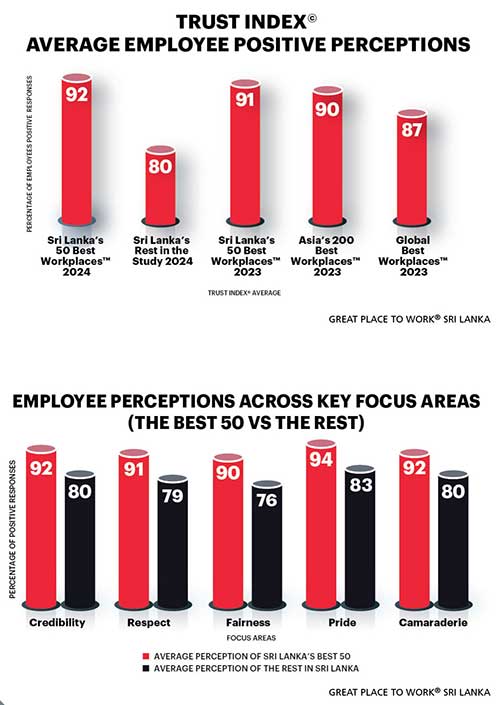 Having faced major challenges in the first half of 2023 with a GDP contraction of 7.9 percent (World Bank – 2024), Sri Lanka’s economy is on the rebound, albeit gradually with a projected growth of 2.2 percent for this year.
Having faced major challenges in the first half of 2023 with a GDP contraction of 7.9 percent (World Bank – 2024), Sri Lanka’s economy is on the rebound, albeit gradually with a projected growth of 2.2 percent for this year.
Despite the relatively positive indicators, persistent issues like poverty, income inequality and low female labour force participation – as well as more recent issues such as government regulatory changes, rising migration and pressure on the existing workforce – continue to take a toll on the work environment.
For the time being, the short-term outlook is positive with greater stability, lower inflation, and foreign exchange reserves being bolstered by thriving tourism and increased remittances (World Bank – 2024), providing opportunities for Sri Lankan organisations to progress in 2024.
Globally, disruptions like the war in Ukraine are reshaping supply chains while AI and digital advancements, as well as a sustainability focus, redefine industries.
To stay competitive in a brittle, anxious, nonlinear and incomprehensible (BANI) world, Sri Lankan workplaces must adapt to these shifts, and become data driven and agile in dynamic decision making, to grasp economic trends and maximise human potential.
It is paramount for employers to heed their workforce, cultivating trust and engagement to attract and retain talent amid economic flux.
The Great Place to Work® study in Sri Lanka provides a snapshot of the current workplace culture and a voice for employees; it illuminates a path that organisations can follow towards sustainable growth.
OVERVIEW This is the 12th consecutive year of the study by Great Place to Work® in Sri Lanka and the results contribute to the largest ongoing global research of its kind, which continues to validate the criteria to be considered a ‘Great Workplace’ and the elite standard of the more exclusive ‘Best Workplace.’
During this year’s study cycle (April 2023 to March 2024), over 87,500 employees were surveyed with an average response rate of 85 percent. More than 180 organisations were assessed, representing a workforce in excess of 96,200 across 20 key industries.
The outlined methodology was maintained in each survey to support the statistical accuracy of the overall study. The results were used to select the list of the best 50 and derive the insights presented in this Cover Story.
THE BIG PICTURE Figure 1 showcases the Trust Index© (TI) scoring, an average derived from employee responses to 58 core global statements, capturing the overall positive perception of employees.
Despite another challenging year, employee perceptions among the best 50 (92%) remained higher than the regional average (90%) and even improved by one percentage point over the prior year. While the rest were catching up in previous years, the average dropped by one percentage point in 2024, widening the gap between the best and the rest to 12 points.
FOCUS AREAS The Trust Index© has five key focus areas that are the pillars of trust: credibility, respect, fairness, pride and camaraderie (Figure 2).
Sri Lanka’s best workplaces outperform their counterparts (‘rest workplaces’) as well as Asia’s best in all five key focus areas. Both the best and rest shine brightly in terms of pride where the gap narrows to 11 percent.
Fairness remains the lowest perceived area with a large gap of 14 percent (i.e. 90% versus 76%), giving the best a competitive advantage over the rest in this category. As a cornerstone of trust, fairness covers many aspects such as equity, social justice, equal opportunity, impartial treatment and fair rewards.
Employees at the best workplaces feel valued and respected (positive sentiment – 91%), which fosters a culture of collaboration. Eighty-nine percent of employees in the best workplaces feel that their management involves them in decisions that affect their jobs or work environment, leading to this sense of being respected. This is in stark contrast to the 73 percent among the rest.
HEALTH INDICES The Trust Index© is akin to an annual medical checkup to investigate a person’s health – except that it assesses the health of organisational culture.
Particular attention is paid to the indicators highlighted in Figure 3 as they are key metrics of Best Workplace™ Culture and determine whether an organisation is a Great Place to Work for All™. It is evident from the results of the best versus the rest that these are key differentiators too.
Employee feedback emphasises that a strong workplace culture leads to a motivated workforce. Employees of the best score 14 percentage points higher than the rest in terms of daily motivation (wanting to come to work) and long-term association (wanting to stay).
Organisations looking to stand out from the rest would do well to focus on the Great Place to Work for All™ indices. The results show that the best do well in striving to build a positive experience for their employees by recognising and celebrating efforts regardless of the outcome at the workplace compared to the rest (92% versus 78%).
The advocacy index shows that the employees in these workplaces take great pride in their organisation and would openly promote it (a 13 point lead compared to the rest).
DEMOGRAPHICS Every organisation’s culture is unique. However, the hallmark of a great workplace is the consistency of positive experiences across the organisation and this can be studied through common demographic patterns.
The Great Place to Work For All™ methodology was used to select the best 50. Therefore, positive employee perceptions were inevitably highly consistent across gender, age and tenure among the best, with perceptions being on a par or within a maximum of a two point gap across the demographic groups.
Notably among the rest, a gap of eight points was seen in tenure with a slight decreasing trend as it increased. And there was a four point gap among age groups with millennials (26 to 34-year-olds) having the lowest perception (78%) compared to the oldest (82%).
INDUSTRY REPRESENTATION There were around 20 key sectors represented in the study. The highest participation was from the manufacturing and production (23%), IT (22%), and transportation and logistics (10%) sectors. Financial sector participation was notably low in this year’s study.
The highest representation among the Best Workplaces list was seen in the manufacturing and production sector, accounting for over 30 percent.
Employee perceptions across key industries are shown in Figure 4. For more detailed employee perceptions in these individual sectors, refer to the sector specific best workplace list reports published by Great Place to Work® in Sri Lanka.
SIZE CATEGORISATION While the Trust Index© fundamentally applies across all types of organisations, it is understood that average employee perceptions can vary on the basis of workforce size.
Figure 5 provides a snapshot of employee perceptions by the size of the workforce among the best 50. It is typical to observe higher employee perceptions with a reduction in the size of the workforce.
KEY DRIVERS The key drivers are areas that are highly correlated to employees perceiving their organisations to be great workplaces. Figure 6 presents the noteworthy key drivers among the best 50 and size categorisations.
While these drivers may change from year to year and across organisations, common drivers have been identified. Among the best 50, the credibility of management and fair treatment remain the top drivers.
The study results reveal an interesting link between the size of an organisation and employee drivers, suggesting that certain factors may resonate more strongly within specific organisational sizes due to their inherent dynamics, as presented in Figure 6. The priority order of these drivers may vary among size categories.
Looking at the unique characteristics, for large organisations, employees appreciate a more personalised and welcoming environment among the masses as well as agility in adapting to change, considering the many processes and greater level of bureaucracy.
For micro size organisations, employees value competent leaders at the helm to guide the organisation and new hires that fit into the team as there is more intimate collaboration within groups.
Among small and medium organisations, employees are looking for better job coordination, and facilities that reduce stress and promote better efficiency.
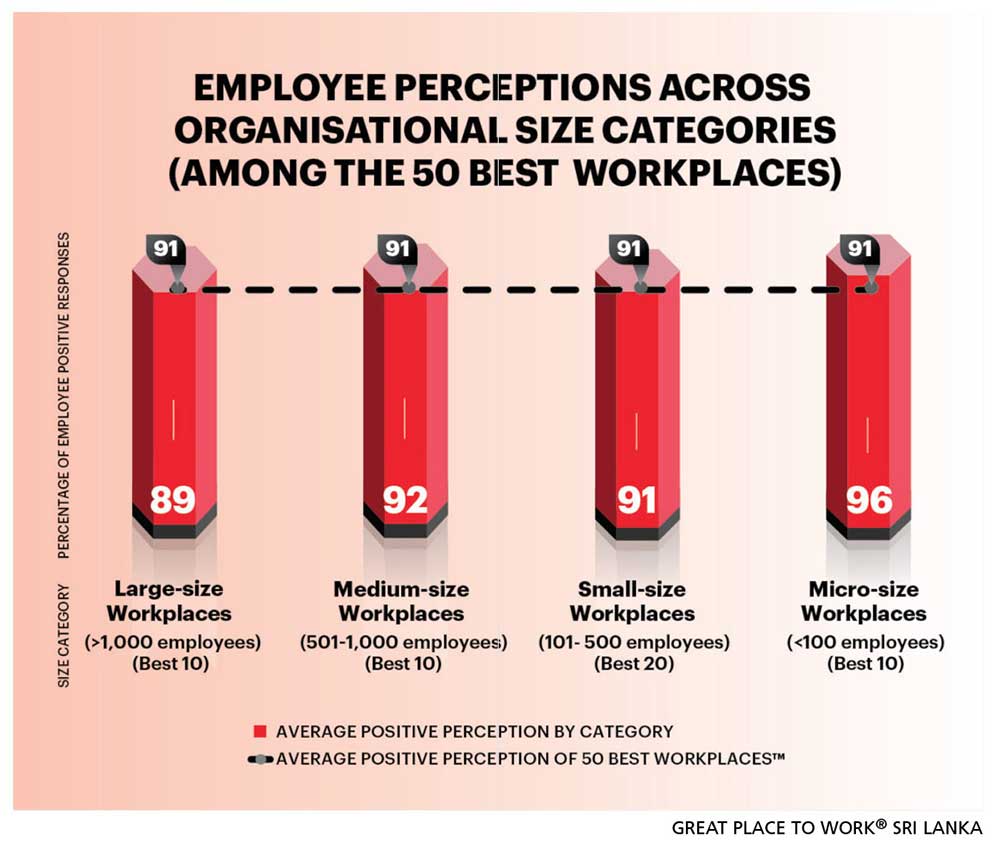 THE BEST VERSUS THE REST
THE BEST VERSUS THE REST
COMMON STRENGTHS Employee perceptions among both the best and the rest continue to be relatively higher in the areas of pride, senior management competence, community level camaraderie and good facilities.
These can be considered the common strengths of the workplace culture in Sri Lanka. The narrowest gap between the best and rest is four points in the perception of physical safety (Figure 7).
KEY DIFFERENTIATORS The 50 best workplaces of 2024 outperform the rest significantly in several key areas, as reflected in Figure 7.
COMPENSATION DISPARITY The best are well ahead of the rest in perceptions about compensation and benefits.
In comparison to the previous year’s study, the perception gap around fair profit share (by eight points) and fair pay (by three points) widened considerably. This is compounded by the fact that unique benefits appeared as a key driver among employees of most large and medium organisations.
EFFECTIVE LEADERSHIP Leadership effectiveness is assessed across categories including manager approachability, business acumen, clarity of vision and genuine employee care. In this area, the best in Sri Lanka maintained their scores from the previous year.
Managers of the best differentiated themselves from the rest by walking the talk in keeping promises more (90% versus 74%) and role modelling ‘living by meaningful values’ to better sustain a great workplace culture.
CONFIDENCE DISPARITY When asked about the level of confidence in management’s judgement, 72 percent of employees in the best said a ‘great deal’ while only 43 percent among the rest said the same – a very telling point. This gap has widened by five points since the previous study.
INNOVATION BY ALL DISPARITY All employees collaborating and contributing to continuous development is a characteristic outcome of a great place to work for all culture.
When asked whether they have significant opportunities to develop new ways of doing things at work, 64 percent of employees in the best replied that they had ‘a lot’ compared to only 37 percent among the rest. This gap also widened by five points from the previous year.
The areas related to encouraging innovation by all had 12-16 point gaps between the best and the rest, making it a key differentiator for the former.
Furthermore, Great Place to Work® research shows that the innovation velocity ratio (IVR) is a simple but telling metric of an organisation’s agility and invention that leads to future growth and sustainability.
IVR represents the number of employees who feel able to innovate against the number of employees who do not feel so. Great Place to Work® found that organisations fall into three broad categories according to their innovation velocity ratios, as shown in Figure 8.
This year, the best 50 have a simple average IVR of seven, which reflects accelerated contributions of employees to innovation efforts versus the rest in the study, which averages at an IVR of two, thereby falling into the friction category.
ROOM TO IMPROVE While the best 50 excel in numerous aspects, there are specific areas to focus on improving to elevate employee engagement further. This was particularly significant when comparing the top 10 with the bottom 10 among the best 50.
While the best collectively outperformed the rest in these areas, there is still much work to be done to improve conditions in workplaces in Sri Lanka. No. 1 is improving fair compensation to support employees, in view of continuous inflation and the high cost of living, and ensuring meritocracy.
Fair performance management and perceived manager behaviour require considerable improvements through manager style programmes that support them to learn about trust building and team relationship management. This would in turn increase the capacity for appreciation for all, and improve bottom-up communication and empowerment, which were also highlighted by employees for corrective action.
Embracing areas to improve as part of growth is vital in fostering trust and accountability, and sustaining organisational growth.
LAST WORDS Sri Lanka’s traditional workplace culture is known to be top-down in nature. Enhancing employee inclusivity in decision making, and increasing transparency in the process and opportunities, can build ownership and set a course for a greater sense of belonging in Sri Lankan workplaces.
By taking into account the employee voices presented in this study, organisations can forge ahead with determination and vision, embracing the opportunity to cultivate environments where trust, empowerment and innovation flourish, and where every workplace is truly a great workplace.
Great Place to Work®’s mission is to help every place become a Great Place to Work For All™ so that organisations can maximise human potential through a High-Trust High-Performance Culture™ that drives business, improves lives and creates a better society.
No matter where you are in your journey, you’re invited to join us and contribute to achieving the vision of making Sri Lanka a great place to work.
CATEGORY AWARDS
The Great Place to Work® category awards celebrate organisations that exhibit distinction in areas related to the Great Place to Work For All™ model, and essentially foster an overwhelmingly positive and consistent work experience for employees, which sustains a High-Trust High-Performance Culture™.
Organisations that best display the criteria are distinguished under four award clusters: Excellence in People Initiatives (two selected practices), the Cube Award for Special Recognition, Organisation Size and Classification, and Legends (organisations listed for five and 10 years in a row).

EXCELLENCE IN PEOPLE INITIATIVES
Great Place to Work® in Sri Lanka considers the Excellence in People Initiatives recognition as an opportunity to build awareness and encourage best practices that support building and maintaining a great workplace culture.
Winners in these categories score high in both the submission highlighting people practices (two-thirds of the final score) as well as their respective employee perception scores (a third of the final score).
The enhanced Great Place to Work For All™ Model has categorised six key areas that an organisation’s management must focus on to create an impactful and consistent employee experience across the workplace that engages them and offers the organisation a competitive advantage over its peers.
For the record, the two practices selected for this year’s awards are relevant to areas that can be better managed within Sri Lanka’s workplace culture to develop greater employee engagement. They are for excellence in ‘living the values’ and ‘encouraging innovation by all.’

EXCELLENCE IN LIVING THE VALUES
Organisational values are not simply what is written on the walls or website of the workplace but what employees experience in their day-to-day work lives and see in the lives lived by their leaders.
Living the values creates a greater sense of pride among employees and cultivates credibility of management. It contributes to a more consitent and impactful experience across the workplace.
The award is bestowed on an organisation that has demonstrated a foundation built on clearly espoused values that are relevant to the business and possibly unique to its culture. There would be a variety of practices and leadership behaviours in which the culture aligns with the espoused values for daily practice.
Evidence of ways the values impact culture are actively showcased in the day-to-day experience of employees, and guide the actions of leaders in strategy and critical decision making would be visible.

EXCELLENCE IN ENCOURAGING INNOVATION BY ALL
Innovation is essential for the sustainable success of a business and should ideally form a primary part of the business strategy.
A Great Place to Work For All™ culture in which all employees can contribute towards innovation in the organisation’s long term is a worplace culture that enables a workforce to continuously improve, adapt quickly and generate pivotal opportunities, by tapping into the intelligence, skills and passion of everyone in it. If fostered, this can support accelerated productivity and growth.
This award is presented on the basis of the extent to which all employees perceive they have been given opportunities to contribute towards making a difference.
To do so, an organisation must first establish people practices that form an intentional approach towards encouraging all employees to periodcally share new ideas and better ways of doing things that contribute to creating and sustaining continuous development.
Secondly, great workplaces would also have in place distinctive policies and programmes that support the recognition and rewarding of employees who participate and contribute to innovation.
And thirdly, there should be a variety of examples and stories of employees in different roles sharing suggestions along with successful implementation, and monitoring the impact of some feasible ideas that can benefit the organisation.
CUBE AWARD FOR SPECIAL RECOGNITION

BEST IN Bold Acts of Leadership/Movement Leadership
The best workplaces have a vision to go beyond simply achieving business performance, and focus on long-term sustainability and having a significant positive impact on the community.
This year’s study continued to collect information around bold acts of leadership made by organisations to create a Great Place to Work For All™ environment for employees and the community.
Movement leadership begins with leaders working towards a profitable business that drives a higher purpose of commitment to making a positive change in the world.
Bold acts or projects to be considered in this area would have a clearly defined scope, substantial investment of resources, evidence of impacts with measurable results, records of stakeholders influenced and why that displays commitment to the cause being promoted by the organisation.
Aligning such programmes with the vision and mission of the organisation helps inspire employees to find greater connection with their workplace.
CATEGORY AWARDS BY ORGANISATIONAL SIZE AND CLASSIFICATION

ORGANISATION SIZE (EMPLOYEE STRENGTH)
The complexities and challenges of sustaining a great workplace culture for all employees change with the size of the employee population.
Therefore, organisations among the Best 50 were selected and ranked within their respective employee strength category (10 micro organisations of 20-100 employees, 20 small organisations of 101-500 employees, 10 medium organisations of 501-1,000 employees and 10 large organisations of over 1,000 employees).

ORGANISATION CLASSIFICATION
This includes the top multinational corporation (MNC) and public limited company (PLC) in Sri Lanka. The leading multinational corporation as well as public limited company in Sri Lanka are selected based on the highest combined score in terms of employee perceptions through the Trust Index© survey and people practices within the Culture Audit©.
LEGEND STATUS
Building culture and enduring as a great workplace is a journey. It takes continued focus and commitment to a cause.
Organisations that have proved their commitment to furthering employee engagement and people management by gaining a consistent place in the Best Workplaces list for five and 10 consecutive years are recognised as ‘Five Year Legends’ and ‘Ten Year Legends’ respectively and inducted in the ‘Hall of Fame.’
SITREK Home Nursing & Swiftcare joined the list of Five Year Legends this year.
DHL Keells and Gamma Pizzakraft Lanka joined AIA Insurance Lanka, DIMO and Oxford College of Business as Ten Year Legends in Sri Lanka’s Hall of Fame.
BEST WORKPLACES IN ASIA
The Great Place to Work® annual study of Asia’s Best Workplaces will felicitate the best workplaces in the Asia-Pacific region and Middle East. The regional list distinguishes organisations under three size categories: Best Multinational Workplaces in Asia, Best Large Workplaces in Asia (more than 500 employees) and Best Small and Medium Workplaces (less than 500 employees) in Asia.
This list considers results from the Sri Lankan study conducted from April 2023 to March 2024. It will be released on 31 August 2024.

